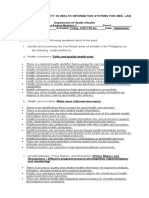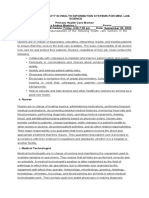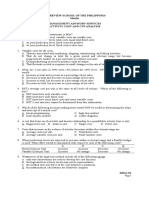Laboratory-Activity-6 HIS-Lab PeHSP PHIE
Laboratory-Activity-6 HIS-Lab PeHSP PHIE
Uploaded by
Caissa Andrea Beatrice BaylenCopyright:
Available Formats
Laboratory-Activity-6 HIS-Lab PeHSP PHIE
Laboratory-Activity-6 HIS-Lab PeHSP PHIE
Uploaded by
Caissa Andrea Beatrice BaylenOriginal Description:
Original Title
Copyright
Available Formats
Share this document
Did you find this document useful?
Is this content inappropriate?
Copyright:
Available Formats
Laboratory-Activity-6 HIS-Lab PeHSP PHIE
Laboratory-Activity-6 HIS-Lab PeHSP PHIE
Uploaded by
Caissa Andrea Beatrice BaylenCopyright:
Available Formats
LABORATORY ACTIVITY IN HEALTH INFORMATION SYSTEMS FOR MED. LAB.
SCIENCE
Philippine eHealth Strategic Plan (PeHSP) and Philippine Health Information Exchange (PHIE)
Name: Baylen, Caissa Andrea Beatrice, I. Score:
Section: 1CMT-4 Schedule: Friday, 4:00-7:00 pm Date: October 14, 2022
DIRECTION: Answer the questions direct to the point
1. Enumerate and Briefly discuss the concepts of Philippine e-Health Strategy Plans.
The PeHSP is organized into four sections:
(1) Strategic Context for eHealth in the Philippines, which displays the country's existing general
health situation and how it fits into the overall eHealth deployment.
(2) A Philippine Health System Enabled by ICT that specifies the overarching eHealth vision,
purpose, goals, and strategic thrusts that are responsive to the entire national health systems and
development goals.
(3) National eHealth Action Plan, which outlines the major strategies, resources, and actions needed
to realize the national eHealth vision.
(4) Monitoring and evaluation, which offer the critical tactical underpinnings to verify that the NeHP is
on track in accordance with the PeHSP standards.
The PeHSP must be updated on a regular basis to reflect changes in the eHealth atmosphere,
national eHealth strategic orientations and priorities, and growing health sector requirements and
health care technology.
2. Enumerate and Briefly discuss the components of Philippine e-Health Strategy Plans.
1) Leadership, Governance, and Multi-Sector Engagement - This will oversee and coordinate the
eHealth objectives, methods, and initiatives at all levels to ensure alignment with the goals of
the national health system and the political environment while fostering a sense of community
and awareness that will engage stakeholders.
2) Legislation, Policy, and Compliance: This department develops and adopts the necessary
national laws, regulations, and protocols for the health sector. It also evaluates the policies of
individual health sector segments for consistency and thoroughness and establishes regular
policy reviews and implementation monitoring.
3) Standards and Interoperability- The adoption of common standards on data structure,
terminology, and messaging facilitates the consistent and correct gathering and interchange of
health information across health systems and services, geographical boundaries, and health
sector boundaries.
4) eHealth Solutions Strategy and Investment- Through the creation of adaptable strategies and
plans to run and maintain the national eHealth environment, this project aims to establish,
execute, and sustain the national eHealth vision. leading planning while including significant
parties and sectors.
5) Infrastructure-Human Resources- This focuses on the workforce or personnel to create, run, or
execute the national eHealth environment, including the healthcare professionals who will
utilize eHealth in their line of work, information and communication technology employees, and
others. Building regional, national, and specialized networks for the deployment of eHealth is
also being paid attention to for improved administration and sustainability.
You might also like
- The Subtle Art of Not Giving a F*ck: A Counterintuitive Approach to Living a Good LifeFrom EverandThe Subtle Art of Not Giving a F*ck: A Counterintuitive Approach to Living a Good LifeRating: 4 out of 5 stars4/5 (5983)
- The Gifts of Imperfection: Let Go of Who You Think You're Supposed to Be and Embrace Who You AreFrom EverandThe Gifts of Imperfection: Let Go of Who You Think You're Supposed to Be and Embrace Who You AreRating: 4 out of 5 stars4/5 (1112)
- Never Split the Difference: Negotiating As If Your Life Depended On ItFrom EverandNever Split the Difference: Negotiating As If Your Life Depended On ItRating: 4.5 out of 5 stars4.5/5 (898)
- Hidden Figures: The American Dream and the Untold Story of the Black Women Mathematicians Who Helped Win the Space RaceFrom EverandHidden Figures: The American Dream and the Untold Story of the Black Women Mathematicians Who Helped Win the Space RaceRating: 4 out of 5 stars4/5 (932)
- Grit: The Power of Passion and PerseveranceFrom EverandGrit: The Power of Passion and PerseveranceRating: 4 out of 5 stars4/5 (619)
- Shoe Dog: A Memoir by the Creator of NikeFrom EverandShoe Dog: A Memoir by the Creator of NikeRating: 4.5 out of 5 stars4.5/5 (546)
- The Hard Thing About Hard Things: Building a Business When There Are No Easy AnswersFrom EverandThe Hard Thing About Hard Things: Building a Business When There Are No Easy AnswersRating: 4.5 out of 5 stars4.5/5 (357)
- Her Body and Other Parties: StoriesFrom EverandHer Body and Other Parties: StoriesRating: 4 out of 5 stars4/5 (831)
- Elon Musk: Tesla, SpaceX, and the Quest for a Fantastic FutureFrom EverandElon Musk: Tesla, SpaceX, and the Quest for a Fantastic FutureRating: 4.5 out of 5 stars4.5/5 (476)
- The Emperor of All Maladies: A Biography of CancerFrom EverandThe Emperor of All Maladies: A Biography of CancerRating: 4.5 out of 5 stars4.5/5 (275)
- The Little Book of Hygge: Danish Secrets to Happy LivingFrom EverandThe Little Book of Hygge: Danish Secrets to Happy LivingRating: 3.5 out of 5 stars3.5/5 (425)
- The World Is Flat 3.0: A Brief History of the Twenty-first CenturyFrom EverandThe World Is Flat 3.0: A Brief History of the Twenty-first CenturyRating: 3.5 out of 5 stars3.5/5 (2272)
- The Yellow House: A Memoir (2019 National Book Award Winner)From EverandThe Yellow House: A Memoir (2019 National Book Award Winner)Rating: 4 out of 5 stars4/5 (99)
- The Sympathizer: A Novel (Pulitzer Prize for Fiction)From EverandThe Sympathizer: A Novel (Pulitzer Prize for Fiction)Rating: 4.5 out of 5 stars4.5/5 (125)
- Devil in the Grove: Thurgood Marshall, the Groveland Boys, and the Dawn of a New AmericaFrom EverandDevil in the Grove: Thurgood Marshall, the Groveland Boys, and the Dawn of a New AmericaRating: 4.5 out of 5 stars4.5/5 (270)
- Team of Rivals: The Political Genius of Abraham LincolnFrom EverandTeam of Rivals: The Political Genius of Abraham LincolnRating: 4.5 out of 5 stars4.5/5 (235)
- A Heartbreaking Work Of Staggering Genius: A Memoir Based on a True StoryFrom EverandA Heartbreaking Work Of Staggering Genius: A Memoir Based on a True StoryRating: 3.5 out of 5 stars3.5/5 (232)
- On Fire: The (Burning) Case for a Green New DealFrom EverandOn Fire: The (Burning) Case for a Green New DealRating: 4 out of 5 stars4/5 (75)
- SMART VocabularyDocument49 pagesSMART VocabularyNidraf Gaming0% (1)
- The Unwinding: An Inner History of the New AmericaFrom EverandThe Unwinding: An Inner History of the New AmericaRating: 4 out of 5 stars4/5 (45)
- Mount Sinai Hospital Audited Financial StatementsDocument62 pagesMount Sinai Hospital Audited Financial StatementsJonathan LaMantia100% (1)
- 14.Kx For Surveillance AlertsDocument31 pages14.Kx For Surveillance AlertsManojNo ratings yet
- Laboratory Activity 5 - HIS Lab - DOH E HealthDocument2 pagesLaboratory Activity 5 - HIS Lab - DOH E HealthCaissa Andrea Beatrice BaylenNo ratings yet
- Laboratory Activity 4 - HIS Lab - Community Health Information Tracking SystemDocument2 pagesLaboratory Activity 4 - HIS Lab - Community Health Information Tracking SystemCaissa Andrea Beatrice BaylenNo ratings yet
- Laboratory Activity 3 - HIS Lab - Classification of Health Care FacilitiesDocument5 pagesLaboratory Activity 3 - HIS Lab - Classification of Health Care FacilitiesCaissa Andrea Beatrice BaylenNo ratings yet
- Laboratory Activity 2 - HIS Lab - Primary Health Care WorkerDocument2 pagesLaboratory Activity 2 - HIS Lab - Primary Health Care WorkerCaissa Andrea Beatrice BaylenNo ratings yet
- Laboratory Activity 7 - HIS Lab - iHOMISDocument2 pagesLaboratory Activity 7 - HIS Lab - iHOMISCaissa Andrea Beatrice BaylenNo ratings yet
- Threading Lightly, Part 3: Sometimes It'S Best Not To Share: Exploiting Threadlocal To Enhance ScalabilityDocument7 pagesThreading Lightly, Part 3: Sometimes It'S Best Not To Share: Exploiting Threadlocal To Enhance Scalabilitysriraman85No ratings yet
- HUAWEI EchoLife EG8010H DatasheetDocument3 pagesHUAWEI EchoLife EG8010H Datasheetrudson32No ratings yet
- The Big Book of PowerShell GotchasDocument54 pagesThe Big Book of PowerShell GotchaseyzxcrrfisynnnksziNo ratings yet
- Employment Transition of Fresh Business Graduates An AssessmentDocument49 pagesEmployment Transition of Fresh Business Graduates An AssessmentCyan Vincent CanlasNo ratings yet
- 2014 Calculus AB Free Response Questions (Answers and Explanations)Document7 pages2014 Calculus AB Free Response Questions (Answers and Explanations)eric100% (1)
- 30936393-MitDocument88 pages30936393-MitJoy Alejandro HakcholnaNo ratings yet
- MOWE-UNDP 2014 - Assessment of Groundwater Resources of LebanonDocument47 pagesMOWE-UNDP 2014 - Assessment of Groundwater Resources of LebanonNassif Abi AbdallahNo ratings yet
- VDZ Interview Global Cement September 2023Document4 pagesVDZ Interview Global Cement September 2023汪文明No ratings yet
- Royal Navy - The Marine EngineerDocument22 pagesRoyal Navy - The Marine EngineerShubham KumarNo ratings yet
- 8008 Deskphone Datasheet enDocument2 pages8008 Deskphone Datasheet enIsrael SousaNo ratings yet
- Teacher: Navarrete Olvera Elizabeth: Lengua Extranjera Level 5Document4 pagesTeacher: Navarrete Olvera Elizabeth: Lengua Extranjera Level 5Marco Antonio Ortega del CarpioNo ratings yet
- Wallkill Hose Company Audit ReportDocument19 pagesWallkill Hose Company Audit ReportDaily FreemanNo ratings yet
- Primavera P6 103 Outline 2014Document3 pagesPrimavera P6 103 Outline 2014Anila SadasivanNo ratings yet
- BrightCast Business PlanDocument46 pagesBrightCast Business PlanMA. CHRISTINA BUSAINGNo ratings yet
- The Post - 2009 Freshman GuideDocument24 pagesThe Post - 2009 Freshman GuideBrock FowlerNo ratings yet
- JOLLIBEEDocument14 pagesJOLLIBEEJoe Nathaniel Arrieta67% (3)
- Start Point (Place From) End Point (Place To) Mode of Travel Total Fare RsDocument1 pageStart Point (Place From) End Point (Place To) Mode of Travel Total Fare RsThirumala NagarajuNo ratings yet
- Sow English Year 4 2023-2024Document12 pagesSow English Year 4 2023-2024AnKadim AwisNo ratings yet
- Foreign Aid and DevDocument16 pagesForeign Aid and DevAyneh MaqpoonNo ratings yet
- NQP Ngpe2022Document8 pagesNQP Ngpe2022Chandan GuptaNo ratings yet
- HACCP L4 Study MaterialDocument88 pagesHACCP L4 Study MaterialRalfy JohnNo ratings yet
- Green Bill: Scan & PayDocument6 pagesGreen Bill: Scan & Paymohamed elmakhzniNo ratings yet
- M168336 Msipa Leroy Individual Assignment 2Document10 pagesM168336 Msipa Leroy Individual Assignment 2LeroyNo ratings yet
- MSQ-01 - Activity Cost & CVP Analysis (Final)Document11 pagesMSQ-01 - Activity Cost & CVP Analysis (Final)Mary Alcaflor50% (6)
- STRATEGIC MANAGEMENT: The Coca-Cola CompanyDocument48 pagesSTRATEGIC MANAGEMENT: The Coca-Cola CompanyASIKIN AZIZ89% (80)
- Excal 2023Document45 pagesExcal 2023sahil ChaudharyNo ratings yet










































































